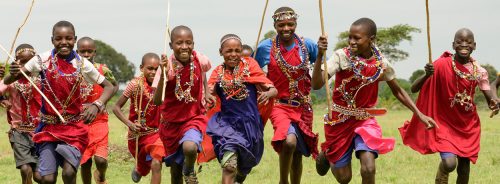The sun slowly rises over the vast sky overlooking an ocean of grass with floating islands of Balanites and its warm embrace bathes the land as the mist recedes. The Mara awakens each day with a vibrant energy that resonates deep within. This same energy can be felt around the Maasai people, the guardians of this land, the deep reds of their attire in contrast to the vibrant greens of the wild.
The Greater Mara ecosystem — including the Mara Triangle, the National Reserve and surrounding conservancies — has one of the most healthy populations of cheetahs in the world, with estimates near 300 individuals. That being said, globally, the species is classified as vulnerable and in many places facing habitat loss, fragmentation, human-wildlife conflict and competition from other cats. Out of all the wildlife experiences, one of the most thrilling for me is watching a cheetah run.
This week, we came across Risasi who was spotted by a ranger near the border, on the move. She silently weaved through the grass, crouched down every few moments and got really low to the ground. Over about two hours, she slowly and ever so cautiously approached a group of topi and two Thomson's gazelles. One gazelle started to stray from the group and unknowingly got very close to Risasi. Then it was on — true to her name (meaning 'bullet' in Swahili), she came bursting out of the grass as if shot from the barrel of a gun. We witnessed the full drama of the complex dance between these animals as they covered hundreds of metres within seconds. The sheer agility and speed of the fastest land animal in the world can leave you speechless. Just as quickly as it started, it was over as she grabbed the gazelle, brought it down and dragged it to a nearby tree.
Not far from the 4km Junction, Angama guide Eric Lemaalo came across some young males from the Serena Pride indulging in a giraffe carcass. It is not clear if it had died of natural causes but we assume so. Hyenas were spotted lurking nearby, which is nothing new, but there was an unusual audience of several giraffes who were also seen watching, possibly wondering what had happened to their fallen brethren.
On a different occasion, toward Mugoro, we saw a lone female that was walking towards a group of impalas; we suspect she is also a member of the Serena Pride. She marched with determination, stopping to scan the environment every few moments, perhaps looking for a meal. The impalas were not going to let her pass unnoticed — as she approached some of the males they immediately began to make a loud alert call informing all the nearby animals of her presence. As the sun began to intensify, she disappeared into the bushes for some shade.
The recent rains have brought plenty of food for the hundreds of bird species in the Triangle. Some of our favourites, like the lilac-breasted roller, ground hornbill and hamerkop, were spotted enjoying some of their favourite meals including grasshoppers, frogs and fish. Besides the local birds, migratory birds have also been seen, like the black stork. In the swampy area of Maji ya Ndege, we found one with beautiful iridescent colours that shimmer in the light of the sun. This less common bird species breeds in Europe and Asia but spends winters in Africa during these months. I must say, the Mara is not a bad place to spend the winter. –Andrew Andrawes
Mt. Kilimanjaro dominates the southwestern horizon of Angama Amboseli on most days, a marvel to anyone who sets their eyes on this gigantic footprint of ancient volcanic activity. While mornings typically offer the best views of the mountain, sometimes it remains shy for most of the day. However, with a scenic flight around the Amboseli ecosystem, you stand a high chance of viewing both peaks from a very different perspective. The team is happy to arrange this for you on-site or in advance if you prefer. We embarked on such a flight with guests this week and, despite Kilimanjaro being obscured from the ground, we were able to capture her full glory at 3,000m.
At Angama Amboseli, like in the Mara, we are dedicated to ensuring that your stay is truly unforgettable and the Photographic Studio provides you with the opportunity to capture the magic of the African wilderness, assisted by a professional photographer on-site. This week, we accompanied guest Stephanie Fletcher on a guided photographic safari into Amboseli National Park. Stephanie's goal was to immortalise her inaugural journey to Africa with captivating images. After a full-day safari and capturing several hundred shots, we convened in the Studio the following day to edit and print some of her finest shots.
Cheetahs, hailed as the fastest land animals as my colleague Andrew mentioned, demonstrate a strong affinity for open savannah landscapes. Their preference for these expansive plains is deeply ingrained in their hunting behaviour, as the vast, unobstructed terrain allows them to utilise their incredible speed and agility to pursue prey with maximum efficiency.
This inclination is particularly evident in habitats like Amboseli National Park, where the flat landscape offers them ample visibility to spot potential targets from afar and execute their lightning-fast sprints without hindrance. In such environments, cheetahs can thrive, exploiting the openness to their advantage in pursuit of sustenance.
As the week drew to a close, we reviewed the footage from our trail cameras and made some intriguing discoveries. While some captured the usual suspects, such as warthogs and the African civet, others revealed creatures making their first appearances on our elusive cameras — like the Egyptian mongoose and large-spotted genet. We'll be keeping a close eye on the cameras for other newcomers to Kimana. –Sammy Njoroge
Filed under: This Week at Angama
Subscribe for Weekly Stories
Comments (0):

The Angama Foundation